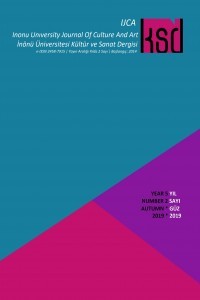MOLDOVA'LI BESTECİ V. ROTARU VE ENSTRUMENTAL ÇALIŞMALARI
Bu makale piyano Trio INO-3 V. Rotaru, yazarın eserindeki önemi, temel tarzı, harmonik, ritmik ve zorlayıcı yönlerini analiz etmeyi amaçlamaktadır. Araştırma, müzikte neo-folklor yönü ile Moldova halk müziğindeki geleneksel türlerin bağlantısı ve geleneksel folklorun modern kompozisyon teknikleriyle sentezini incelemektedir.Bu makale, Trio INO3 adlı eserin V. Rotaru'nun bu türdeki diğer eserlerini temsil ettiğini varsaymaktadır. Makalede ayrıca, besteciye ait neo-folklor müzikal tarzın özellikleri, Rus besteciler ve Batı Avrupalı bestecilerin klasik gelenekleri ile uyumlu kombinasyonları üzerinde durulmaktadır.Klasik geleneklere gelince, Trio karakteristik tempo özelliklerine sahip üç bölümlü bir döngüdür:I. ModeratoII. Lento e molto lamentoIII. Allegro moderato Bu Trio, bu döngünün sonuncusu olması, bestecinin ölümünden kısa bir süre önce yazılması ve yazarın orta kısımdaki Saraband yas türüne hitap etmesi yönü ile ilginçtir. Neo-folk tarzı unsurlara gelince, kompozisyonun bütün tematik, ritmik ve harmonik malzemesini tanımlamaktadır. Eser, Moldova folklorunun karakteristik tonlama formülleri olan Trio'nun tüm bölümlerine odaklanmaktadır: II artı ve azalmış seviyeli motifler, IV artmış seviyeli motif, VI artmış seviye, melismatikle zenginleştirilmiş. Besteci, eserinde ritm açısından, değişken değerler ve değişen vurgular ile hızlı Moldova danslarının ritmik formüllerine vurgu yapmaktadır. Topluluk dokusu, topluluk üyelerinden birinden diğerine aktarılan tematikizmin sıkça çeşitlendirilmesinin yanı sıra, taklit, canon ve kontrast polifoni gibi zengin polifonik tekniklerlede sık sık oluşan klasik geleneklere geri döner. Genel olarak, trio INO3, ülkemizde ve yurtdışında pedagojik ve konser pratiğinde talep edilmeye değer, canlı figüratif kontrastlara sahip bir konser bileşimidir.
Anahtar Kelimeler:
V. Rotaru, oda topluluğu, stil özellikleri, neofolkloric özellikler, topluluk dokusu, polifonik teknikler
THE MOLDAVIAN COMPOSER V. ROTARU AND HIS CHAMBER-INSTRUMENTAL WORK.
This article analyzes the piano Trio INO-3 V. Rotaru, its significance in the author's work, the basic style, the harmonic, rhythmic and inerprtative aspects. The connection with neo-folklore direction in music and traditional genres in Moldovan folk music is revealed, the synthesis of traditional folklore with modern composition techniques.This article assumes to define first of all value of the considered Trio INO-3 in the context of all area of chamber-instrumental music of V. Rotaru, as the last composition of the composer in this genre sphere. The article also focuses on the neo-folklore features of the composer's style and their harmonious combination with the classical traditions typical of the trio of Russian and Western European composers. As for the classical traditions, the Trio is a three-part cycle with a characteristic tempo dramaturgy:I. ModeratoII. Lento e molto lamentoIII. Allegro moderatoSince this Trio is the last in the cycle and was written shortly before the composer's death, the author's appeal to the genre of mourning Saraband in the middle part is of interest. As for the neo-folk style elements, they define the whole thematic, rhythmic and Lado - harmonic material of the composition. The article focuses on the Lado - harmonic features of all parts of the Trio, which are characteristic intonation formulas of Moldovan folklore: motives with II increased and decreased levels, motives with IV increased level, VI increased level, enriched with melismatics. From the point of view of rhythm, the composer relies on the rhythmic formulas of fast Moldovan dances, with variable meters and changing accents. The ensemble texture goes back to the classical traditions, which consist in frequent variation of thematism transmitted from one member of the ensemble to another, as well as in rich polyphonic techniques such as imitation, Canon and contrasting polyphony. In General, the trio INO3 is a concert composition with vivid figurative contrasts, which is worthy of being in demand in pedagogical and concert practice in our country and abroad.
Keywords:
V. Rotaru, chamber ensemble, style features, neofolkloric features,
___
- 1. Н. Козлова, С. Циркунова, Камерно – ансамблевая музыка в республике Молдова: Вопросы теории, истории и методики преподавания, изд-во Pontos, Chisinau, 2014. 2. Е. Мироненко, Композитор В. Ротару, изд-во «Tipografia centrala», Chisinau, 2000. 3. V. Taran, Omul de creație și compozitorul Vladimir Rotaru. În: Univers pedagogic pro. 2016, 7 apr., p. 8. 4. Н. Голубовская, О музыкальном исполнительстве, изд. Москва, Музыка, 1985. 5. Музыкальная энциклопедия, гл.ред. Ю.Келдыш, изд. «Советская энциклопедия», 1974.
- İnternet Source
- https://www.moldovenii.md/md/people/67 https://www.oxfordmusiconline.com/grovemusic/view/10.1093/gmo/9781561592630.001.0001/omo-9781561592630-e-0000044361
- ISSN: 2458-7915
- Başlangıç: 2014
- Yayıncı: İnönü Üniversitesi
Sayıdaki Diğer Makaleler
CHİCK COREA’NIN DOĞAÇLAMA ÜSLUBU ÜZERİNE BİR ANALİZ
MOLDOVA'LI BESTECİ V. ROTARU VE ENSTRUMENTAL ÇALIŞMALARI
ULUSAL GASTRONOMİ KİMLİĞİNİN GELİŞTİRİLMESİ VE TURİSTİK TANITIMINDA KARŞILAŞILAN SORUNLAR
TURİZMDE GASTRONOMİ VE EKSLİBRİS
İRFAN ÖNÜRMEN RESMİNDE MALZEMENİN KATMANLI KULLANIMININ DUYUSAL KARŞILIKLARI ÜZERİNE BİR İNCELEME
